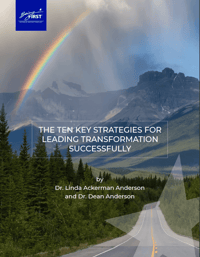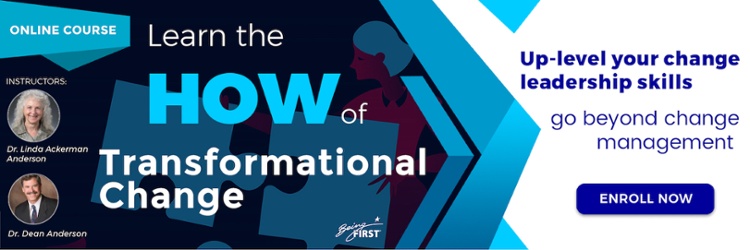Therapists have long touted the importance of active listening skills in interpersonal relationships. Listening actively isn't just a way to support someone you care about, though. A Wall Street Journal article on active listening points out that what is good for the speaker is also good for the listener. Active participation encourages the speaker, reduces attention burnout in the listener, and enhances overall communication. While the Wall Street Journal article concentrates on listening within a personal relationship, the truths it shares are relevant to a business environment. At Being First, we’ve been teaching advanced applications of active listening to executive change leaders for four decades and can attest to its powerful impact.
Creating Positive Change through Active Listening
One of the top reasons for failures in change management is that consultants or team leaders are not appropriately equipped to deal with communication on a personal level. Positive, proactive change requires not just conversation, but a lot of communication—leaders, project teams, and consultants must be able to listen to needs, understand limitations, and present information in a way that engages staff and executive support. By using active listening, change management staff and business leaders become more aware of the organic needs within an organization, making change decisions more impactful. They know how to be a good listener and also digest and respond to concerns in a more appropriate, timely manner, leading to reduced fear and increased buy-in and support of change.
Steps to Active Listening
Active listening takes work, but it's a skill with significant ROI for those who take the time to master it. Most who attempt to learn active listening do not progress beyond learning the steps and mechanically applying them. This often has those being actively listened to feel “techniqued” rather than feel connected with. True mastery of active listening only comes to those who realize that it is a way being in relationship with others, rather than a series of steps or techniques to follow. The essence of active listening is being fully present with another human being where they feel fully seen and heard. We like to think of it as “holding the space” for another, where we reflect back what they say so they can deepen their own introspection and resolve a current challenge.
Active listening is ideally used when the speaker is either emotionally upset or mentally confused, not all the time. By being actively listened to, the speaker often resolves his or her own mental or emotional challenge.
Below are some steps to incorporate into your active listening in business conversations, but remember, more important than the steps is your intent to really support and hear the other person.
Be Present for the Conversation
Take a moment to center yourself before entering an important conversation, especially if you know it will be difficult or complex. Breathe and relax. Set aside other thoughts and priorities so you can be an attentive listener by concentrating on the needs or words of the speaker instead of worrying about the last conversation you had or planning your strategy for an upcoming meeting.
Remove as many distractions as possible. Turning away from a computer screen—or turning the monitor off completely—is beneficial both for yourself and the speaker. Positioning yourself toward the speaker, presenting open body posture, and making eye contact are all signals that you are fully present to the other person. Keeping phones, computers, devices, and other people out of a conversation lets you concentrate on what the speaker is saying so they feel fully attended to and valued. This is a core of active listening.
Reflect Back Without Judgment
The key to active listening is “giving the other back to themselves.” This means reflecting back what you hear them saying—without adding your judgments, opinions or good ideas that you think would solve their challenge. In normal conversation, it is of course acceptable and useful to provide your opinions and perspectives, but not as you enter active listening. To reflect back effectively, you might use sentence stems like, "What I hear you saying is..." or "It sounds like what you’re experiencing is…”
By reflecting back what they say, you literally help them stay on their train of thought, which enables them to go deeper, often resolving for themselves either their ill feelings or their confusion.
Sounds simple, but it ain’t easy, especially for leaders. We have a tendency to jump into a conversation too early with our own ideas, opinions and judgments—especially if the discussion involves something we are passionate about. Presenting our ideas or judgments makes the conversation about us at that moment. The key is to let the speaker have his or her time and space. Hear what the person is saying using active listening and reflect that back to them, keeping yourself a relatively neutral party. When you “hold the space” for another this way, the majority of the time they’ll solve their own issue and leave the conversation feeling empowered and more clear. Plus, you’ll deepen your relationship and build trust at the same time.
Confirm Your Understanding
At appropriate times after a more complex part of their disclosure, and after you have reflected back what they’ve just said, overtly ask if you’ve got it right. Confirming your understanding lets the person know that you are really with them, which reassures them and helps them feel safe. Remember, you are only actively listening because they are either upset or confused, both of which are tenuous internal states.
After overtly confirming your understanding, pause and give them a moment. Silence is good here! You’ll often see them thinking or feeling more deeply, and then finding some new terrain within themselves they want to share. Confirming helps them continue to go deeper into their own thoughts and feelings, and that’s the primary intent.
Ask Deepening Questions
Only once you sense the person is really feeling heard and you have confirmed understanding should you start asking questions. The key to active listening is letting the speaker control the direction and pace of the conversation. When we ask questions in a normal conversation, it’s no big deal, but when someone is upset or confused, it often derails their thinking and takes them in our direction of inquiry. This requires careful navigating.
When we teach active listening, we tell executives not to ask any questions until they can sense that the person really feels complete in their sharing and fully heard. Only at that time are your questions of potential value for deepening their inquiry.
Active listeners—especially those in leadership or influencer positions—should always be mindful that they have the power to redirect a conversation. While redirection is a useful tool, particularly when trying to focus a person or team’s attention to get back on track, avoid using it during active listening. Redirection shifts ownership of the conversation from the speaker to the listener. Instead, work on acknowledging, encouraging, and understanding the other person.
Once a person has exhausted their own sharing, you can dig deeper into root causes, reasons, and reactions. You might ask questions such as, "Why do you think you feel this way?" Or "What is the most important goal to achieve in this situation?" Or, ”What might you do to resolve the issue?” Questions that deepen their inquiry can be extremely useful to them, but only after they’ve been able to process the already-available thoughts and feelings they initially carried into the conversation. While becoming skilled in this part of active listening will take discipline and practice on your part, it will make you more effective as a change leader.
The bottom line in active listening is to remember that your part is to be fully present to the other and reflect them back to themselves so they can deepen their inquiry and resolution of something that is troubling them. Good luck. As you master this “way of being” in relationship, you’ll watch trust, openness and deeper relationships flourish around you.
Related eBook:
The Ten Key Strategies for Leading Transformation

Through 40 years of observing and supporting large-scale change and transformation in Fortune 500, government, global NGOs and public service organizations, we’ve identified these ten Best Practice strategies for leading transformation successfully.
Please complete the form to download your eBook:



